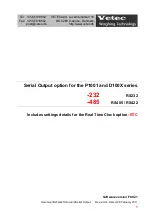
5
It is called longitudinal or linear time code because it was originally recorded along the length of a video tape by a
stationary recording head as the video was being recorded as magnetic stripes on the rest of the tape by a spinning
recording head. After recording, SMPTE time code enables video and audio recordings to be synchronized to each
other during playback using specialized playback devices and software.
Instead of being just a continuously incrementing count, SMPTE time code identifies each frame of a television
picture by counting in an hours, minutes, seconds and frame number format. It has a starting value of 00:00:00:00
and a maximum value after 24 hours of 23:59:59:29 (23 hours, 59 minutes, 59 seconds, and 29 frames) for the
29.97/30 FPS frame rate, a maximum value of 23:59:59:24 for 25 FPS frame rate, and a maximum of 23:59:59:23
for the 23.976/24 FPS frame rate.
The LTC signal itself is an 80-bit serial binary code that repeats once each video frame. Of these 80 bits, 32 are
reserved for the time information. An additional 32-bits, known as user bits, are available for including
miscellaneous information along with the time information. These user bits are organized as eight, 4-bit
hexadecimal digits. A hexadecimal has a value of from 0 to 9 and then from A to F. The remaining 16 bits of time
code form a special "sync" pattern which is used to locate and decode the time code and user bit information.
When a tape with time code is played back, the time code signal can be read by appropriate equipment to provide a
precise frame and/or time identification for video editing, audio synchronizing, and other purposes.
Depending upon the capabilities of the playback machine, the TR-100 can read and decode LTC signals at speeds as
slow as 1/30th times play speed up to speeds as high as 10 times play speed.
3.2 Drop Frame Time Code
Drop frame time code is a form of SMPTE code which is used when it is important that the time code time value
also be an accurate representation of real time. Drop frame is not used for the 25 FPS EBU or 24 FPS film time code
format.
U.S. color television standards were first developed to be compatible with earlier black and white television. This
required a slight slowing down of the (then) standard black & white TV frame rate of 30 frames-per-second, down
to 29.97 frames-per-second. Because it is this frame rate that increments the SMPTE time code numbers, the time
code readout falls behind real clock time by about 108 frames per hour, or 3.6 seconds. 3.6 seconds is important to
television broadcasters selling air time, so drop frame time code was developed to adjust for this error and make
29.97 FPS SMPTE time code time more closely match real time like 30 FPS time code would.
The technique for producing drop frame time code involves skipping ahead by two frame numbers on each new
minute except on minutes 00, 10, 20 , 30, 40, and 50. Thus, except for these tens-of-minutes exceptions, drop frame
time code advances from frame number 29 to frame number 02, skipping frame numbers 00 and 01 at the start of
each new minute. This effectively causes the time display to catch up and match that of a real time clock.
Although drop frame time code is widely used in the broadcast industry, it is often avoided elsewhere due to
problems in handling it by various video and audio editing and control equipment.
4
CONNECTING THE TR-100
4.1 Connecting Power
Included with your TR-100 is an AC power adapter that provides a 9 volt, 500 milliamperes DC output. This
adapter is equipped with a miniature phone plug with the "+" (positive) voltage output connected to the front tip of
the plug.
Insert the power plug into the "+9V DC" rear panel connector and plug the adapter into 110-120 volt, 60-Hz AC
power.
WARNING:
ELECTRICALLY OPERATED PRODUCT
As with all electrical products, precautions should be observed during handling and use to prevent electrical shock.


























